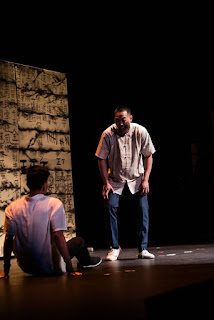Week 6: Biotechnology and Art
In high school, I participated in a two-year medical research program where I had the chance to work with a PhD student to study the effects of specific tumor suppressors in lung cancer. From my scientific vantage point, it was interesting to learn about BioArt because I had never considered scientific research techniques as being artwork.
One form of BioArt that I really appreciated was Davis' usage of microbiology and sound, his map of the Milky way in a transgenic mouse's ear. Davis' procedure of translating art, like it was actually RNA, into a mouse paralleled the reality of what occurs in nature, thereby heightening the artistic merit. But, his usage of this technique brings up the issues of ethics and usefulness of modifying, harming these organisms, in order to create art. With the integration of science in the artistic production process, comes the concerns of consent and morality that is rarely heard of in the artistic world. In science, at least, manipulating animals produces scientific progress, but what type of tangible utility is generated in the case of art? That question is tricky to answer and one that may become more important as more artist integrate biotechnology into their creative processes.
In this week's lecture, Professor Vesna spoke about Eduardo Kac's GFP Bunny, Alba. I was taken aback because I had learned and so often used this scientific procedure in my own research experience. For context, GFP is utilized to tag particular proteins that one is studying in order to discern these proteins' presence in specific biological pathways. In countless ways, a myriad of Alba forms are utilized in different research labs across the world. Interestingly, there are numerous ways in which one can interpret why Alba is an art, but personally, I wonder why people think it is? One way could be the transgenic element involved, Kac's intentional fusing of genetic material from two species together. Another interpretation might be that it is art because it is a green bunny. Perhaps my personal experience in research labs makes it harder to appreciate the artistic value of Kac's GFP Bunny, but undoubtedly it was an innovative creation.
Works Cited:
https://alchetron.com/Joe-Davis-(artist)-491035-W
https://upload.wikimedia.org/wikipedia/commons/thumb/0/0d/%D0%9C%D1%8B%D1%88%D1%8C_2.jpg/1200px-%D0%9C%D1%8B%D1%88%D1%8C_2.jpg
https://www.youtube.com/watch?v=Mvf3hOpiG1Q
Works Cited:
Delgado, Rick. “How Artists are Blending Biotechnology and Art.” Future Tech, Creative. Mud. 8 May 2015. Web. 15 May 2017.
Hussain, Zareena. “Science as Art Unites Disciplines.” The Tech (Online Edition). The Tech, MIT. 9 May 2000. Web. 15 May 2017.
"The World According to Monsanto." DocumentaryHeaven. N.p., n.d. Web. 06 May 2017. <http://documentaryheaven.com/the-world-according-to-monsanto/>. Lorraine_chow. "Monsanto's Unapproved GMO Wheat Found Growing in Washington State." EcoWatch. EcoWatch, 02 Aug. 2016. Web. 06 May 2017. <http://www.ecowatch.com/monsantos-unapproved-gmo-wheat-growing-washington-1954609745.html>.'
Sagasti Lab. "Morphogenesis of Sensory Neurons and Skin." Sagasti Lab Home. Sagasti Lab, n.d. Web. 15 May 2017.
Slawson, Kim. "Eduardo Kac's GFP Bunny, a Work of Transgenic Art, Or, It's Not Easy Being Green." Everything2.com. Kac Web, 19 Nov. 2000. Web. 15 May 2017.






Comments
Post a Comment